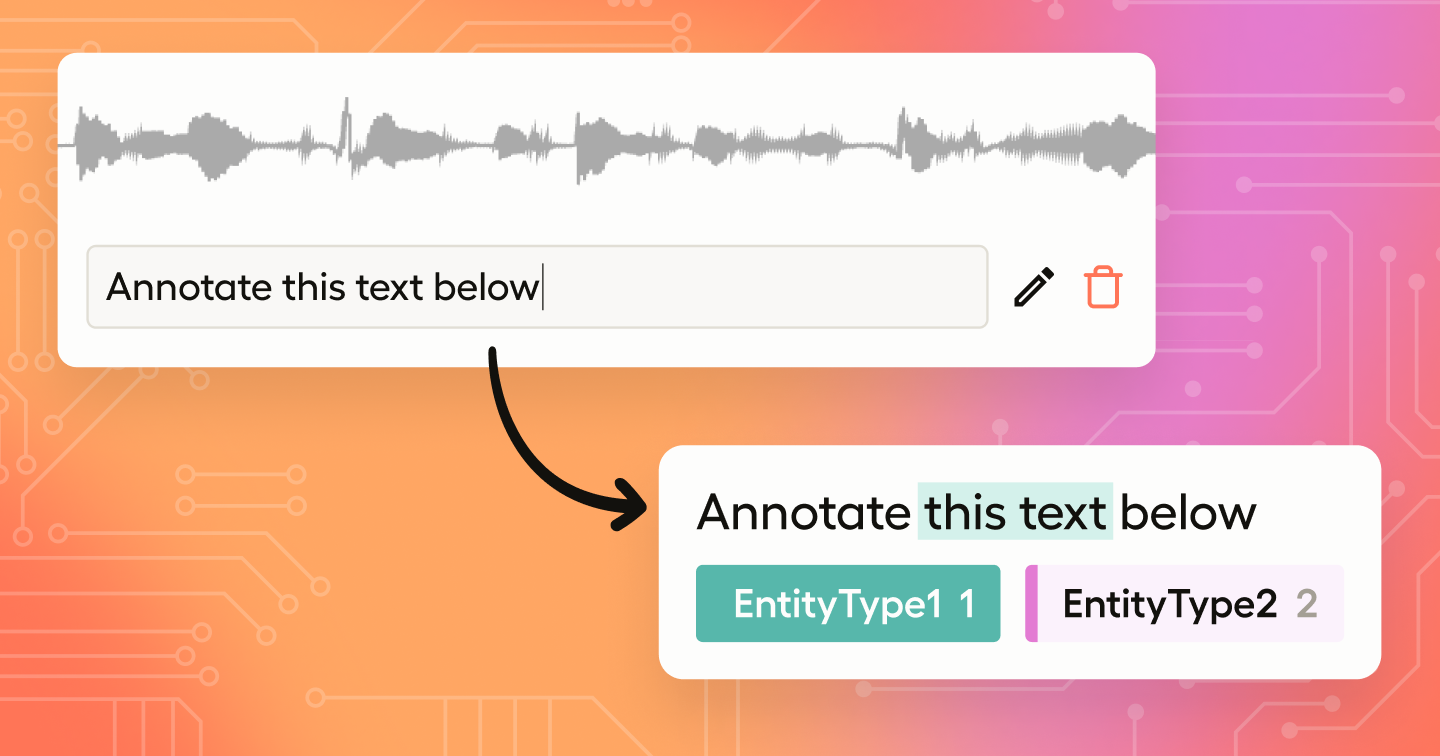Dynamic Text Spans

note
For information about modifying this plugin or creating your own custom plugins, see Customize and Build Your Own Plugins.
For general plugin information, see Plugins for projects and Plugin FAQ.
About
This plugin “binds” a TextArea to a Text field, keeping them in sync as you edit. You can then apply labels to the text in the Text field, allowing you annotate text that is unique from the text you imported.
How this plugin works:
It defines two tag names:
TextAreaistranscriptionTextisextraction_text
It captures the current annotation ID so that it can stop running when you switch regions.
In Once found, it marks it
_already_loadedand startstick(), which runs every 300 ms:- If the DOM node got replaced (e.g. you re-loaded or changed annotation), it re-queries for it.
- If you’ve moved to a different annotation ID, it stops.
- It grabs the live DOM value (
$ta.value) or falls back to the annotation’s last saved result. - It compares that string to the current
_valueof yourextraction_textcontrol. - If they differ, it calls
text.setRemoteValue(val). This uses the Label Studio frontend API to update the other field’s value.
init(), it polls every 300 ms until it finds the whose name starts with “transcription” (Label Studio appends random suffixes).
The net effect is a real-time mirror: whatever you type or paste into the “transcription” TextArea automatically appears in the “extraction_text” Text field. And, importantly, the text you annotate in the Text field can be exported with your results.
Plugin
const TEXTAREA_NAME = "transcription";
const TEXT_NAME = "extraction_text";
const current_annotation = LSI.annotation.id;
(function init() {
// textarea results have names like "tag_name:h4$h", so we use ^=
let $ta = document.querySelector(`textarea[name^="${TEXTAREA_NAME}"]`);
if (!$ta) return setTimeout(init, 300);
if ($ta._already_loaded) return;
$ta._already_loaded = true;
(function tick() {
// it can be another textarea with submitted result
if (!$ta?.isConnected) {
$ta = document.querySelector(`textarea[name^="${TEXTAREA_NAME}"]`);
}
// if we lost textarea/moved out of current annotation — break the cycle
if (!$ta?.isConnected || LSI.annotation?.id !== current_annotation) return;
setTimeout(tick, 300);
const textarea = LSI.annotation.names.get(TEXTAREA_NAME);
const text = LSI.annotation.names.get(TEXT_NAME);
const val = String($ta.value ?? textarea.result?.value.text ?? "");
if (text._value !== val) {
text.setRemoteValue(val);
}
})();
})();Related LSI instance methods:
Labeling interface
<View>
<Header value="1. Transcribe the audio below:"/>
<Audio name="audio" value="$audio" zoom="true" hotkey="ctrl+enter"/>
<TextArea
name="transcription"
toName="audio"
rows="4"
editable="true"
maxSubmissions="1"
showSubmitButton="false"
value="$text"
/>
<Header value="2. Extract spans from the transcript:"/>
<!-- force HyperText into the DOM via non-breaking space -->
<View idAttr="extractionBlock">
<Text
name="extraction_text"
idAttr="extractionText"
value="$transcription"
inline="false"
/>
</View>
<Labels
name="span_labels"
toName="extraction_text"
choice="multiple"
showInline="true"
>
<Label value="EntityType1" background="#8cc6ff"/>
<Label value="EntityType2" background="#ffa39e"/>
</Labels>
</View>Related tags:
Sample data
{
"data": {
"audio": "https://data.heartex.net/librispeech/dev-clean/3536/8226/3536-8226-0024.flac.wav",
"transcription": "",
"text": "this is a test"
}
}